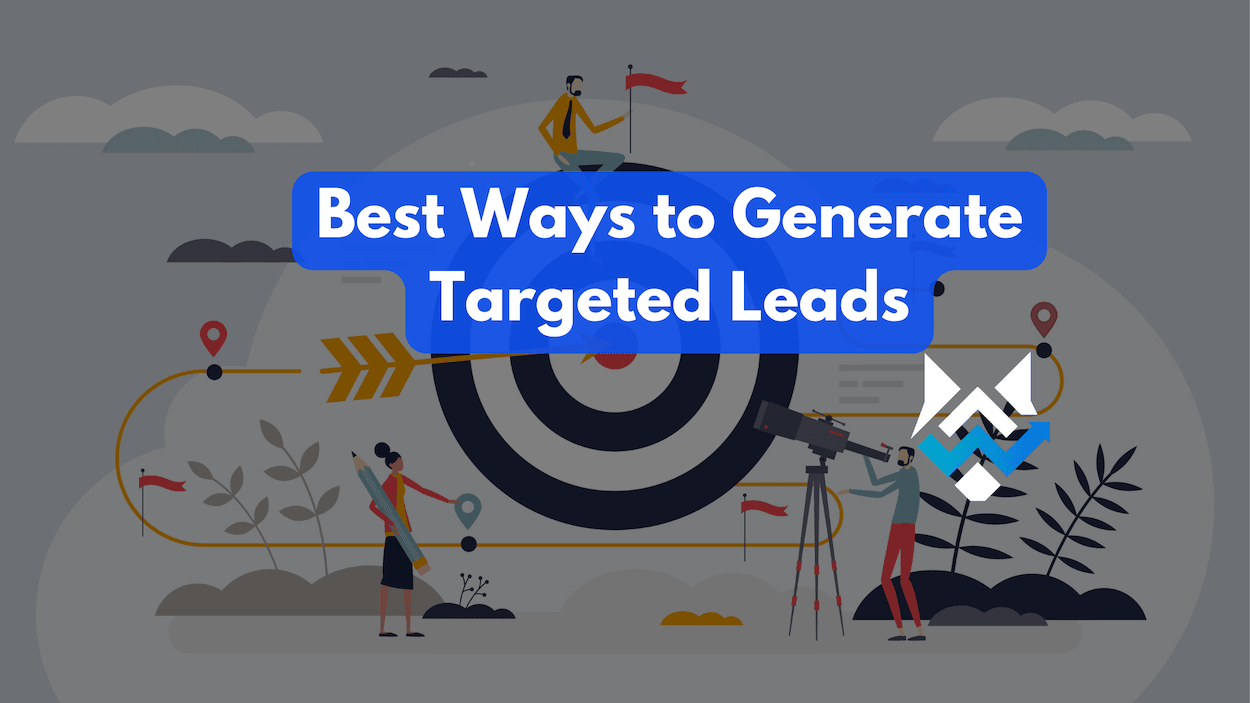Last updated on June 5th, 2024 at 01:11 pm
The strategic use of targeted leads stands out as a cornerstone for success. As businesses navigate through potential customers, the ability to pinpoint and engage with the right prospects becomes crucial.
This focused approach not only streamlines the sales process but also enhances the effectiveness of marketing campaigns. In this context, we delve into the significance of targeted leads and lay the groundwork for uncovering strategies that can transform your sales and marketing efforts.
If you’re looking to generate targeted leads, try these strategies: leverage social media, use PPC, and implement marketing automation. Utilize hashtags, analyze your demographics and locations, and tailor your approach to male, female, and age ranges. For an easy-to-read guide, check out the detailed strategies below!
Understanding Targeted Lead Generation

Targeted lead generation is a strategic approach that zeroes in on specific individuals who are most likely to become your customers. By tailoring your marketing efforts to a well-defined audience, you not only use your resources more efficiently but also significantly boost your return on investment (ROI).
Recent research underscores the value of this method, revealing that companies with robust lead-generation strategies can experience up to 133% more revenue compared to those without such practices.
What Are Targeted Leads?
Imagine you have a pool of potential customers; targeted leads are those who fit perfectly into your ideal customer profile. They are the ones who check all the boxes in terms of demographics, behaviors and needs that align with what your business offers.
The Advantages of Targeted Lead Generation
1. Increased ROI
By focusing your marketing dollars on a select group of prospects, you’re not casting too wide a net. This precision targeting means that more of your leads are likely to make a purchase, giving you a better bang for your buck.
2. Higher Conversion Rates
When you understand your audience and tailor your messages to their specific challenges and desires, they’re more likely to take notice and act. This personalized approach can dramatically improve your conversion rates.

This mindmap diagram illustrates how understanding your audience and tailoring messages to their specific challenges and desires can improve conversion rates. It breaks down the process into key areas:
- Research: Conducting market analysis, customer surveys, and gathering social media insights.
- Personalization: Crafting tailored messages that address specific challenges and desires of the customers.
- Engagement: Focusing on capturing attention, generating interest, and prompting action.
- Conversion Rates: Highlighting the impact of these efforts in terms of improved conversions and better ROI.
3. Better Customer Relationships
Targeted lead generation allows for more personalized interactions. When customers feel understood and valued, they develop a stronger connection to your brand, which can lead to long-term loyalty.
4. Lower Churn Rates
Customers acquired through targeted efforts tend to be more satisfied because they’ve found a solution that truly fits their needs. Happy customers are less likely to leave, reducing your churn rates and stabilizing your revenue.
Putting It Into Practice
Let’s say you run an online fitness apparel store. Instead of marketing to everyone interested in exercise, you could target leads by focusing on yoga enthusiasts within a certain age range and geographical location. By doing so, you can create tailored marketing campaigns that resonate deeply with this group, leading to higher engagement and sales.
Thus, targeted lead generation isn’t just about finding any leads; it’s about finding the right leads. By honing in on those who are most likely to benefit from and appreciate your offerings, you’ll see a marked improvement in your marketing effectiveness. Start implementing targeted lead generation today, and watch as your business grows not just in size but in efficiency and profitability.
Creating an Ideal Customer Profile (ICP)
An Ideal Customer Profile (ICP) is not just a tool—it’s the compass that guides your business toward more effective lead generation and customer acquisition. By meticulously analyzing consumer data and engaging with existing customers, your sales and marketing teams can crystallize a clear picture of your target market. This clarity enables you to sharpen your marketing efforts, ensuring that every dollar spent is an investment in reaching the people most likely to benefit from your offerings.
The Significance of an ICP
The creation of an ICP is not merely beneficial; it’s a strategic imperative. Consider this: companies that exceed lead and revenue goals are over twice as likely to create personas than those that miss these targets, according to a study by the ITSMA. Here’s why an ICP matters:
- It helps you understand the unique characteristics of your best customers.
- It allows for personalized marketing campaigns that resonate on a deeper level.
- It informs product development, ensuring that features meet specific customer needs.
- It directs resources toward the most promising prospects, enhancing ROI.
Steps to Create an ICP
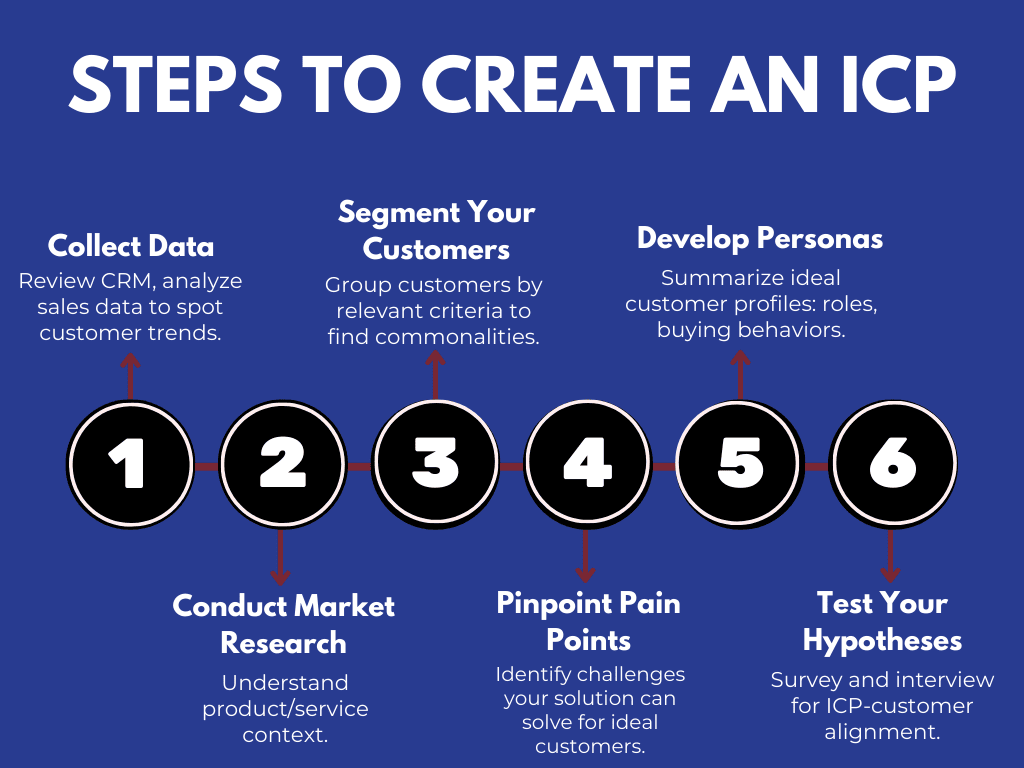
- Collect Data: Review your CRM and analyze sales data to identify trends among your current customers.
- Conduct Market Research: Understand the broader context in which your product or service operates.
- Segment Your Customers: Group your customers based on relevant criteria to identify commonalities.
- Pinpoint Pain Points: Determine the challenges your ideal customers face that your solution can alleviate.
- Develop Personas: Craft detailed profiles for your ideal customers, including their roles and buying behaviors.
- Test Your Hypotheses: Use surveys and interviews to ensure your ICP aligns with actual customer experiences.
Analyzing Consumer Data
Delve into consumer data to uncover patterns in demographics, purchasing habits, online behavior, and feedback from customer support interactions. For instance, you might find that 70% of your loyal customers use mobile devices to engage with your content, indicating the need for a mobile-first marketing approach.
Engaging with Existing Customers
Leverage direct feedback through:
- Surveys and questionnaires
- One-on-one interviews
- Focus groups
This engagement can reveal why customers chose your product, the benefits they’ve experienced, and areas for improvement.
Benefits of an ICP in Targeting Leads
A well-crafted ICP can transform your lead-targeting strategy. Here’s how:
- It increases message relevance, attracting leads that are more likely to convert.
- It reduces acquisition costs by weeding out unqualified leads early on.
- It boosts retention rates by ensuring your value proposition aligns with customer needs.
- It guides content creation to address the specific interests and pain points of your ICP.
Today, understanding and implementing an Ideal Customer Profile is not just advantageous—it’s essential. It empowers businesses to focus their energies on cultivating relationships with customers who will not only benefit most from their products but also contribute to sustainable growth. Start building your ICP today, and watch as your business becomes more aligned with the needs of your market, leading to increased satisfaction, loyalty, and success.
Building a Targeted Lead List: A Strategic Approach
Creating a targeted lead list is a cornerstone of a successful outbound marketing strategy. The process involves more than just gathering contacts; it’s about curating a list that aligns with your business objectives and enhances campaign effectiveness.
Understanding the Value of High-Quality Data
In the digital age, data is king. However, not all data is created equal. Manual list-building can be fraught with errors and inefficiencies. In contrast, utilizing a reputable data source like UpLead can dramatically improve the quality of your lead lists. UpLead offers:
- Access to verified phone numbers and emails.
- Tools to segment and target specific demographics.
- A 95% accuracy guarantee, ensuring you’re reaching out to valid prospects.
Manual List Building vs. High-Quality Data Sources
| Manual List Building | High-Quality Data Sources |
| Time-consuming | Time-efficient |
| Prone to errors | Highly accurate |
| Hard to scale | Easy to scale |
Tools for Efficient Lead Generation
Leveraging tools such as UpLead can streamline your lead-generation process. These platforms offer features like:
- Advanced Search Filters: Pinpoint leads based on industry, location, company size, and more.
- List Segmentation: Organize your leads for tailored marketing campaigns.
- Real-Time Verification: Ensure the contact information is current and valid.
Emphasizing Data Accuracy
Data accuracy isn’t just a detail—it’s the foundation of effective marketing. Accurate data ensures that your message reaches the intended audience, which is crucial for achieving a high return on investment (ROI). Consider these points:
- A mere 1% increase in data quality can result in a significant boost in ROI.
- Accurate data reduces bounce rates, enhancing email deliverability and sender reputation.
- High-quality data leads to better engagement and conversion rates, as your messages are more likely to resonate with the recipients.
Taking Action
Building a targeted lead list with precision requires the right approach and tools. By prioritizing data quality and leveraging efficient lead-generation platforms, you can create powerful marketing campaigns that drive results. Start by evaluating your current lead generation process and consider integrating a tool like UpLead to elevate your strategy.
Remember, every interaction with a potential customer begins with a single piece of data. Make it count.
Segmenting Your Lead Lists
Email list segmentation is a powerful tool in the arsenal of any marketer aiming to expand their customer base. By categorizing your lists, you can deliver content that speaks directly to the needs and interests of specific audience segments. This targeted approach not only enhances the relevance of your communications but also significantly boosts the chances of engagement. In fact, studies have shown that segmented email campaigns can lead to as much as a 760% increase in revenue. Segmentation empowers you to track and analyze the behavior of different groups, providing invaluable insights for refining your marketing strategies.
The Advantages of Email List Segmentation
- Increased Relevance: Tailored messages resonate more deeply with recipients.
- Higher Engagement Rates: Relevant content naturally leads to more opens and clicks.
- Improved Conversion Rates: Personalized emails are more likely to convert leads into customers.
- Efficient Resource Allocation: Focus your efforts and resources on the most responsive segments.
- Data-Driven Decisions: Segmentation provides data that can guide future campaign adjustments.
Effective Segmentation Techniques
Demographic Segmentation
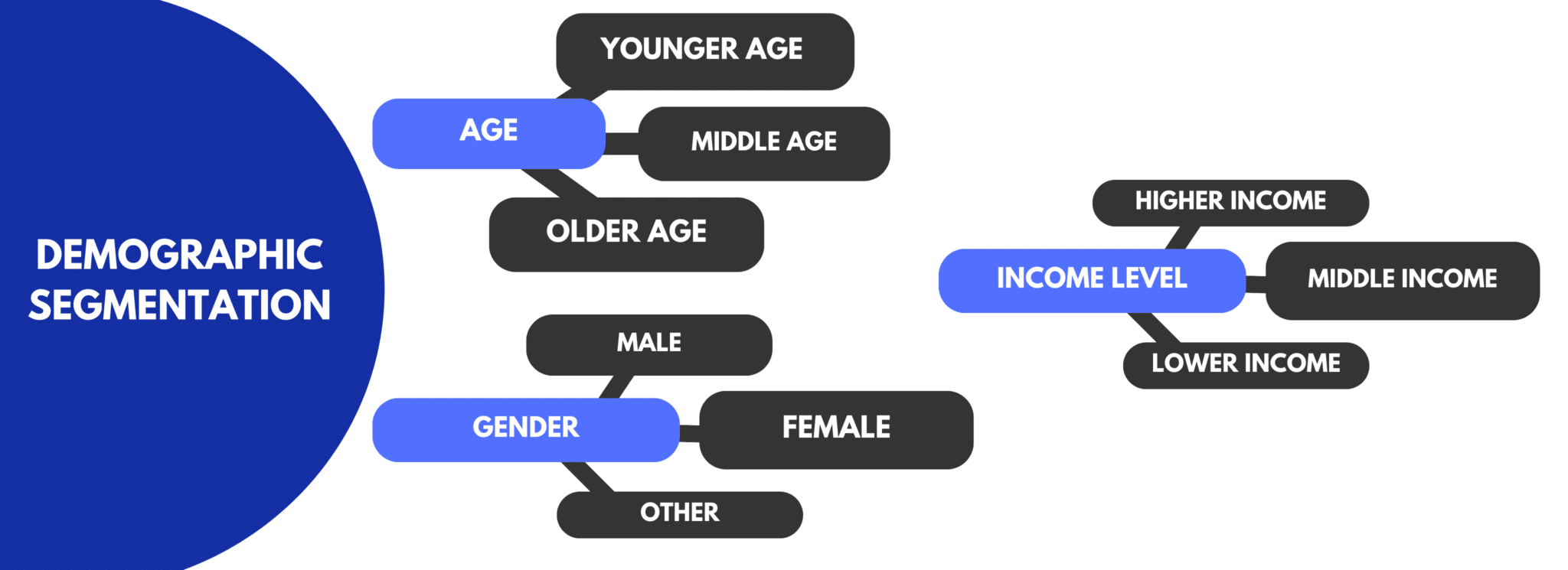
- Demographic Segmentation is the central concept, represented at the top of the diagram.
- This segmentation is divided into four main branches: Gender, Occupation, Income Level, and Age
Branches and Examples:
- Gender:
- Male
- Female
- Other
- Occupation:
- University Students: Targeted by educational institutions.
- Professionals: Targeted by luxury brands, professional services, etc.
- Retired Individuals: Could be targeted for leisure, healthcare services, etc.
- Income Level:
- Lower Income
- Middle Income
- Higher Income: Targeted by luxury car brands for exclusive offers and premium services.
- Age:
- Younger Age: Targeted by universities to promote undergraduate programs.
- Middle Age: Targeted by luxury car brands for exclusive offers.
- Older Age: Could be targeted for products and services relevant to this demographic.
This diagram visually represents how different demographic characteristics can be targeted by various products and services, emphasizing how specific segments like higher income or younger age groups are approached by brands and institutions.
Psychographic Segmentation

- Psychographic Segmentation is the central concept, represented at the top of the diagram.
- This segmentation is divided into four main branches: Personality Traits, Values, Beliefs, and Lifestyle Choices.
Branches and Examples:
- Personality Traits:
- Motivation Levels: A fitness app could target users with high motivation levels by offering challenging workout plans and competitive features.
- Health Goals: A fitness app could also segment users based on their specific health goals, such as weight loss, muscle gain, or improving cardiovascular health, and offer personalized workout plans accordingly.
- Values:
- Environmental Consciousness: Targeting users who value eco-friendly practices by promoting sustainable fitness gear or green initiatives.
- Social Values: Targeting users who value community and social interaction by offering group workouts or social challenges.
- Personal Values: Catering to individual preferences and values in fitness, such as a focus on mental well-being or holistic health.
- Beliefs:
- Religious Beliefs: Offering workout plans that respect and align with religious practices, such as timings and dietary restrictions.
- Philosophical Beliefs: Targeting users with specific philosophical beliefs, such as mindfulness or minimalism, with appropriate fitness routines.
- Cultural Beliefs: Customizing workout plans and health advice to align with cultural beliefs and traditions.
- Lifestyle Choices:
- Healthy Living: Promoting a healthy lifestyle with balanced diet plans, regular exercise routines, and wellness tips.
- Active Lifestyle: Catering to users who lead an active lifestyle with dynamic and high-energy workout plans.
- Leisure Oriented: Offering more relaxed and fun workout options for users who prefer a leisurely approach to fitness.
This diagram visually represents how different psychological attributes can be targeted by a fitness app to offer personalized and engaging workout plans, emphasizing how specific segments like motivation levels or health goals are approached to meet user needs effectively.
Behavioral Segmentation
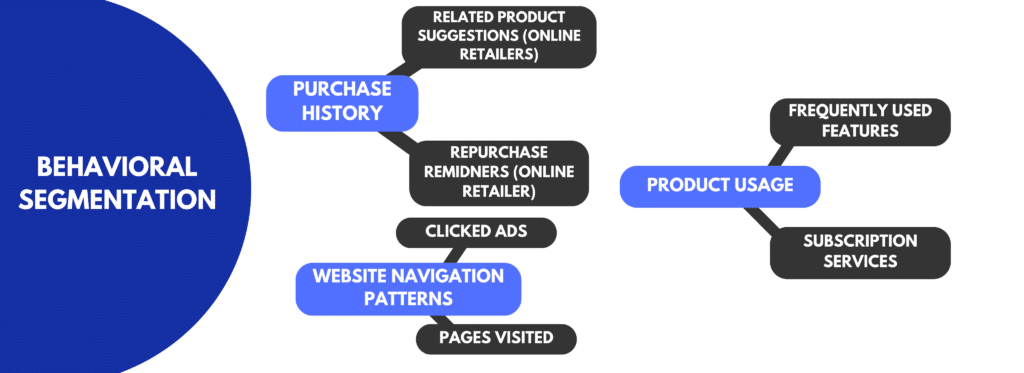
- Behavioral Segmentation is the central concept, represented at the top of the diagram.
- This segmentation is divided into three main branches: Purchase History, Website Navigation Patterns, and Product Usage.
Branches and Examples:
- Purchase History:
- Related Product Suggestions: An online retailer might analyze a customer’s past purchases to suggest related products. For example, if a customer frequently buys sports equipment, the retailer might suggest new sports gear or accessories.
- Repurchase Reminders: An online retailer can also use purchase history to remind customers when it’s time to repurchase consumable items. For example, if a customer buys a 30-day supply of vitamins, the retailer can send a reminder near the end of the month to reorder.
- Website Navigation Patterns:
- Clicked Ads: Tracking which ads a customer clicks on can help the retailer understand their interests and tailor future ads to be more relevant.
- Pages Visited: By analyzing the pages a customer visits on the website, the retailer can understand their preferences and suggest products or content that align with their interests.
- Product Usage:
- Frequently Used Features: For a software product, understanding which features are used most frequently can help in developing targeted marketing campaigns or product improvements.
- Subscription Services: If customers are subscribed to certain services, the retailer can offer additional products or upgrades related to those services.
This diagram visually represents how different past behaviors and interactions with the brand can be used to segment the audience. It emphasizes how specific segments like purchase history or website navigation patterns can be leveraged by an online retailer to offer personalized recommendations and reminders, thereby enhancing customer engagement and satisfaction.
Geographic Segmentation
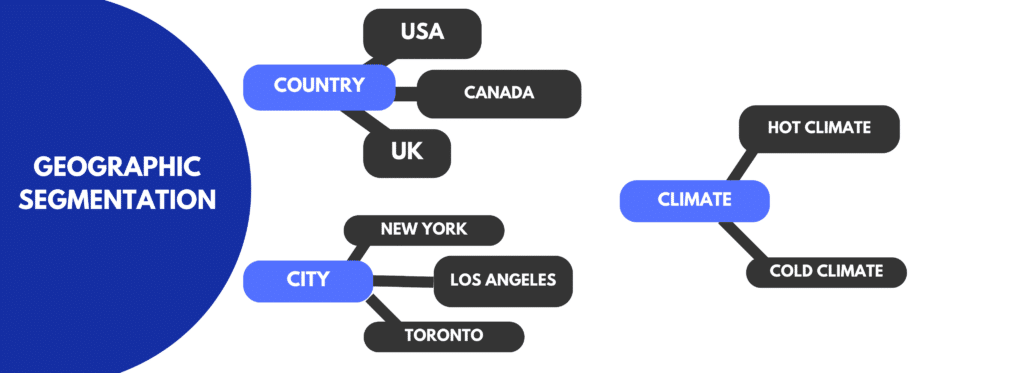
- Geographic Segmentation is the central concept, represented at the top of the diagram.
- This segmentation is divided into three main branches: Country, City, and Climate.
Branches and Examples:
- Country:
- USA
- Canada
- UK
- City:
- New York: A major city in the USA.
- Los Angeles: Another major city in the USA.
- London: A major city in the UK.
- Toronto: A major city in Canada.
- Climate:
- Hot Climate
- Cold Climate: Targeted by companies selling winter gear. For example, a company selling winter gear would focus on regions with colder climates, tailoring their marketing campaigns to the onset of winter in each geographic area. This might involve promoting winter jackets, boots, and accessories as the weather begins to cool, ensuring that the marketing messages are relevant and timely for the audience in these regions.
This diagram visually represents how different geographic attributes can be used to segment the audience. It emphasizes how specific segments like country, city, and climate can be leveraged by a company to tailor their marketing efforts. For instance, a company selling winter gear would particularly focus on regions with colder climates, adjusting their marketing strategies to align with seasonal changes in each geographic area.
Crafting Content for Segmented Lists
When creating content for a segmented list, it’s crucial to align your message with the defining characteristics of that segment. For instance, if you’re targeting a demographic segment of new parents, your content should address common concerns and interests related to parenting. Similarly, for a behavioral segment of frequent purchasers, exclusive loyalty rewards or advanced product releases can be very effective.
Remember, the goal of segmentation is not just to send different emails to different groups, but to forge a stronger connection with your audience by addressing their specific needs and desires. By doing so, you’re not only educating them about relevant products or services but also showing that you value and understand them. This approach fosters trust and loyalty, which are the cornerstones of any successful customer relationship.
Segmentation is less about dividing your audience and more about uniting your brand with customers in a meaningful way. Take the step towards more personalized, effective marketing by segmenting your lead lists today.
Developing Relationships with Leads
Cultivating strong relationships with potential customers is a cornerstone of business growth. When your sales and marketing teams engage with the right prospects—those who are most likely to convert—their efforts can yield a higher return on investment (ROI). Here’s how you can make every interaction count.
Strategies for Initial Outreach
- Conduct Thorough Research: Begin by understanding your prospects. A study by LinkedIn showed that 76% of buyers prefer to work with recommendations from their professional network. Tap into this by learning about your prospect’s business needs, challenges, and industry trends.
- Personalize Your Communication: Tailored messages can lead to a 20% increase in sales opportunities, according to Aberdeen Group. Address your prospects by name, reference specific pain points, and offer solutions that resonate with their unique situation.
- Select Appropriate Channels: Whether it’s through email, social media, or direct calls, choose the channels where your prospects are most active. For instance, B2B companies often find LinkedIn an effective platform for engaging decision-makers.
- Optimize Timing: Timing can significantly impact response rates. For example, emails sent on Tuesdays have shown to have the highest open rate. Test and learn to identify when your prospects are most receptive.
Importance of Personalized and Relevant Messaging
- Foster Connection: By speaking directly to your prospect’s interests, you’re not just selling a product; you’re offering a solution. This approach helps build a connection that goes beyond transactional relationships.
- Boost Engagement: Personalization isn’t just nice to have; it’s expected. In fact, Experian found that personalized emails deliver six times higher transaction rates. But don’t just personalize names; tailor content to meet their specific business needs.
- Establish Trust: Consistently providing value through relevant messaging helps establish trust—a key factor in any purchasing decision. Remember, people buy from those they trust.
Tracking and Refining Interactions
- Keep Records: Use a Customer Relationship Management (CRM) system to log interactions. This will help you understand which strategies are working and which aren’t.

- Leverage Analytics: Regularly review your outreach performance. Are there patterns in the responses? What content gets the most engagement? Use these insights to inform your strategy.
- Iterate and Improve: With each campaign, refine your approach. If a particular message yields high engagement, consider how you can replicate its success in future communications.
- Commit to Learning: The landscape of customer engagement is always changing. Stay committed to learning and adapting your strategies to stay ahead of the curve.
In essence, developing relationships with leads requires a blend of strategic outreach, personalized communication, and ongoing refinement based on data-driven insights. By implementing these practices, your sales and marketing teams can create meaningful connections that not only foster trust but also drive business success. Take action today, and watch as your efforts translate into lasting customer relationships and increased ROI.
Nurturing Leads
In marketing, your initial outreach is merely the beginning. It’s akin to planting a seed that requires consistent care to grow. Nurturing leads in this ongoing process, is essential for cultivating potential customers into loyal patrons. Engaging with leads regularly not only builds relationships but also instills trust and confidence in your offerings.
Why Regular Follow-Up is Crucial
The importance of follow-up cannot be overstated. A study by Marketing Donut revealed that 80% of sales require at least five follow-ups after the initial contact. However, 44% of salespeople give up after just one follow-up. This gap represents a significant opportunity. By nurturing leads effectively, you can:
- Keep the lines of communication active.
- Ensure your brand remains top-of-mind.
- Provide valuable content that addresses their needs.
- Guide them through the decision-making process.
Strategies for Effective Lead Nurturing
Here are actionable strategies to enhance your lead nurturing efforts:
1. Embrace Automation

Automated follow-up sequences can streamline your marketing efforts. For instance, setting up an email drip campaign can ensure timely and relevant engagement with your leads. Automating these sequences allows for consistent touchpoints without overwhelming your resources.
2. Personalize Your Approach
Personalization is more than using a lead’s name in an email. It’s about tailoring the experience to their specific interests and past interactions with your brand. According to Epsilon, 80% of consumers are more likely to make a purchase when brands offer personalized experiences.
3. Implement A/B Testing
A/B testing is a powerful tool to optimize your lead nurturing strategy. By comparing two versions of an email or landing page, you can determine which elements perform better and refine your approach accordingly. Continuous testing leads to improved engagement and conversion rates.
4. Foster Trust Through Engagement
Building trust is a marathon, not a sprint. Regular, meaningful interaction with your leads can establish a foundation of trust. Share insights, offer solutions to their problems, and demonstrate your commitment to their success.
Remember, lead nurturing is an investment in your business’s future. By adopting these strategies, you’re not just selling a product or service; you’re building a community of engaged customers who believe in what you do. Take the first step today, and watch as your nurtured leads blossom into a thriving customer base.
Lead generation is the lifeblood of any thriving business, and mastering it can significantly boost your growth. Here’s how you can effectively generate leads that are likely to convert into loyal customers.
Effective Lead Generation Techniques
Lead generation is the lifeblood of any thriving business, and mastering it can significantly boost your growth. Here’s how you can effectively generate leads that are likely to convert into loyal customers.
High-Quality Data Sources: The Foundation of Lead Generation
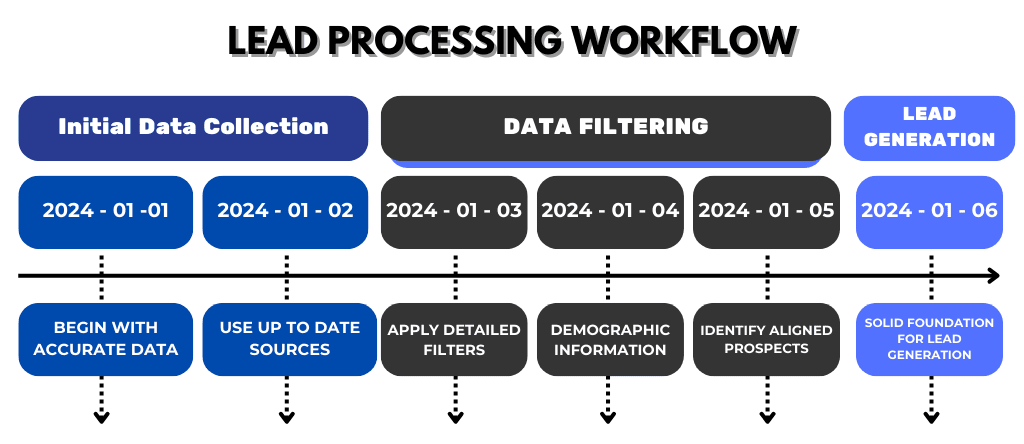
Begin with accurate data; it’s non-negotiable. Services like UpLead boast a 95% accuracy guarantee, providing a solid foundation for your lead generation efforts. By utilizing detailed filters such as technographic and demographic information, you can pinpoint prospects who are most aligned with your offerings.
Cold Calling and Emailing: Direct Engagement with Precision
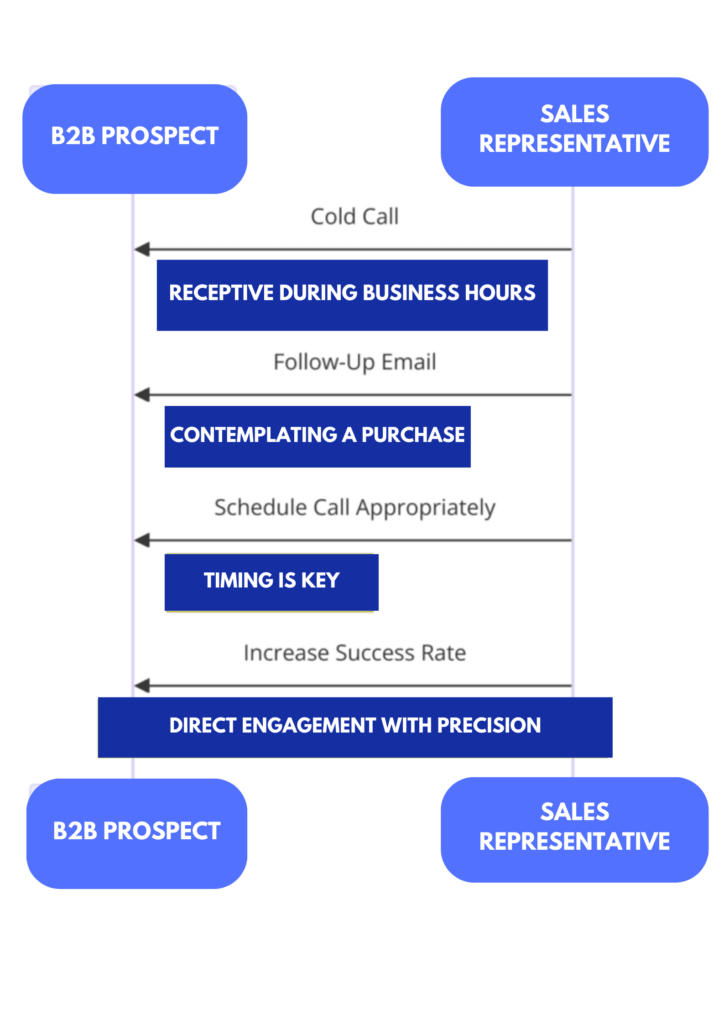
Participants
- B2B Prospect: The target individual or company that the sales representative is trying to reach.
- Sales Representative: The person making the cold call and sending follow-up emails to engage with the prospect.
Workflow Steps
- Cold Call:
- The Sales Representative initiates a cold call to the B2B Prospect.
- Note: This interaction highlights that prospects are more receptive during their business hours.
- Follow-Up Email:
- After the cold call, the Sales Representative sends a follow-up email to the B2B Prospect.
- Note: This step is crucial when the prospect is contemplating a purchase.
- Schedule Call Appropriately:
- The Sales Representative schedules subsequent calls at times that are convenient for the prospect, ensuring better engagement.
- Note: Timing is key in this step to increase the likelihood of a positive response.
- Increase Success Rate:
- By engaging with the prospect when they are most receptive and scheduling calls appropriately, the Sales Representative significantly increases the success rate of their efforts.
Overall Engagement
- Note: The diagram emphasizes “Direct Engagement with Precision,” showcasing the strategic importance of timing and appropriate scheduling in the cold calling and emailing process to maximize effectiveness.
Landing Pages: Your Digital Handshake

Think of your landing page as a digital handshake—it needs to be firm, confident, and inviting. A/B testing reveals that pages with clear value propositions and calls-to-action can improve conversions by over 11%. Ensure your landing page clearly communicates benefits and provides a seamless action step for visitors.

Content Marketing: Educate and Engage
Content is not just the king; it’s the entire kingdom. Educational blog posts, insightful social media content, and informative email campaigns can establish your brand as an authority. For example, companies that blog get 67% more leads than those that don’t. Use content to solve problems answer questions, and watch your credibility soar.
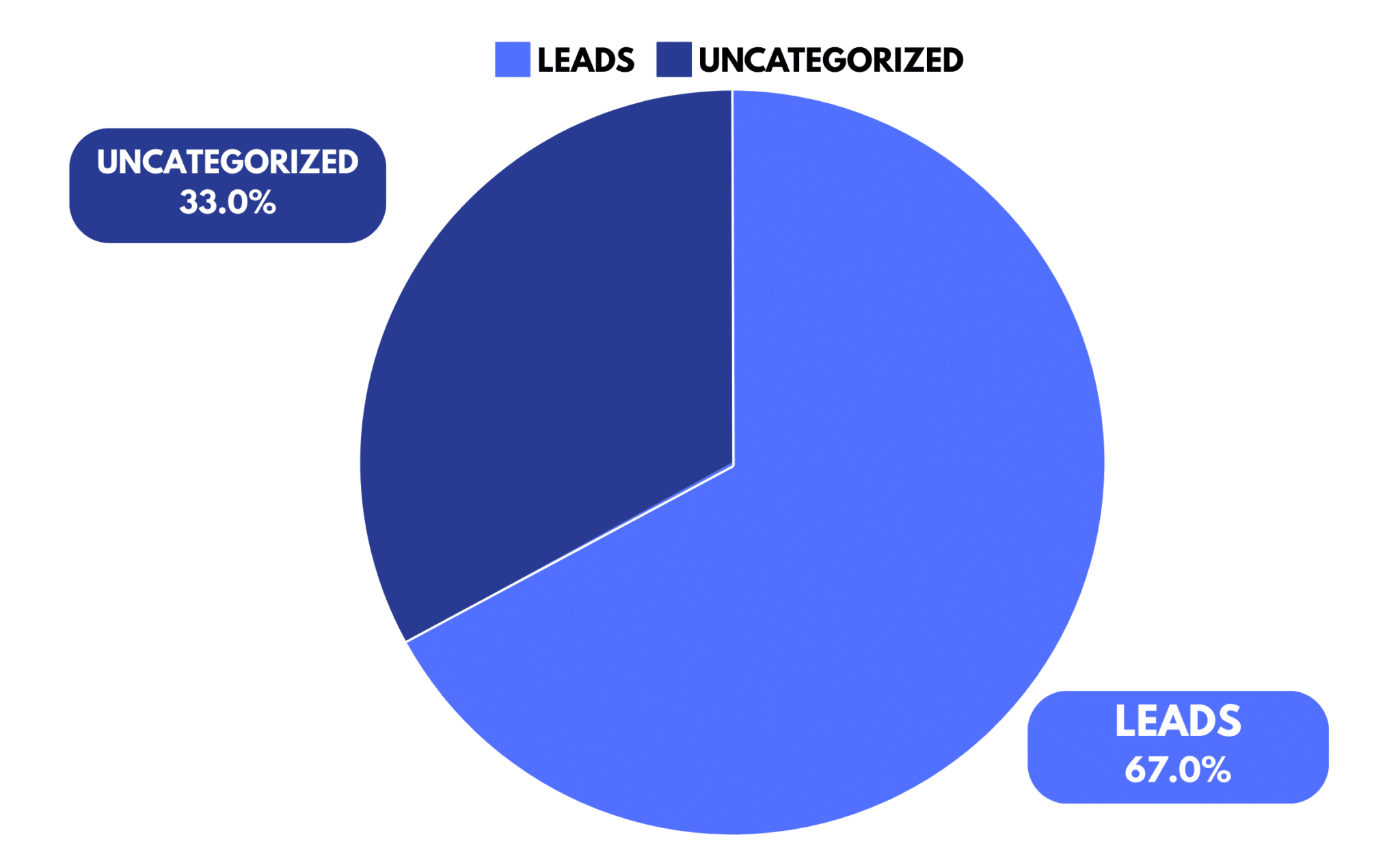
Social Media: Building Trust One Post at a Time
Social media platforms, especially LinkedIn for B2B businesses, offer fertile ground for establishing trust and demonstrating expertise. Regularly sharing valuable insights and engaging with your audience can turn followers into leads. In fact, 80% of B2B leads come from LinkedIn, making it a goldmine for lead generation.

Paid Advertising: Targeted Visibility
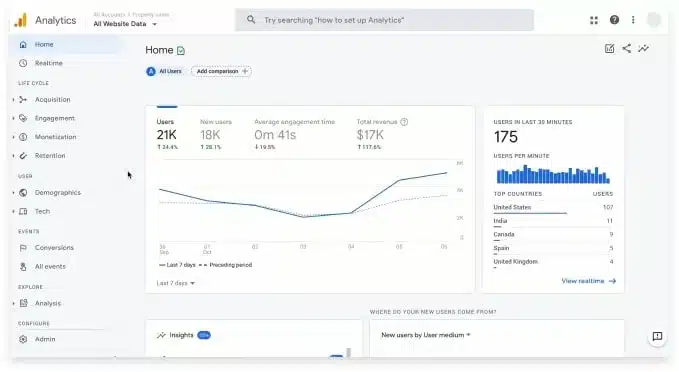
Paid ads can catapult your visibility to the right audience. Platforms like Google Ads allow you to target specific demographics, interests, and even behaviors. With the average person exposed to around 4,000 to 10,000 ads each day, make yours count by being relevant and compelling.
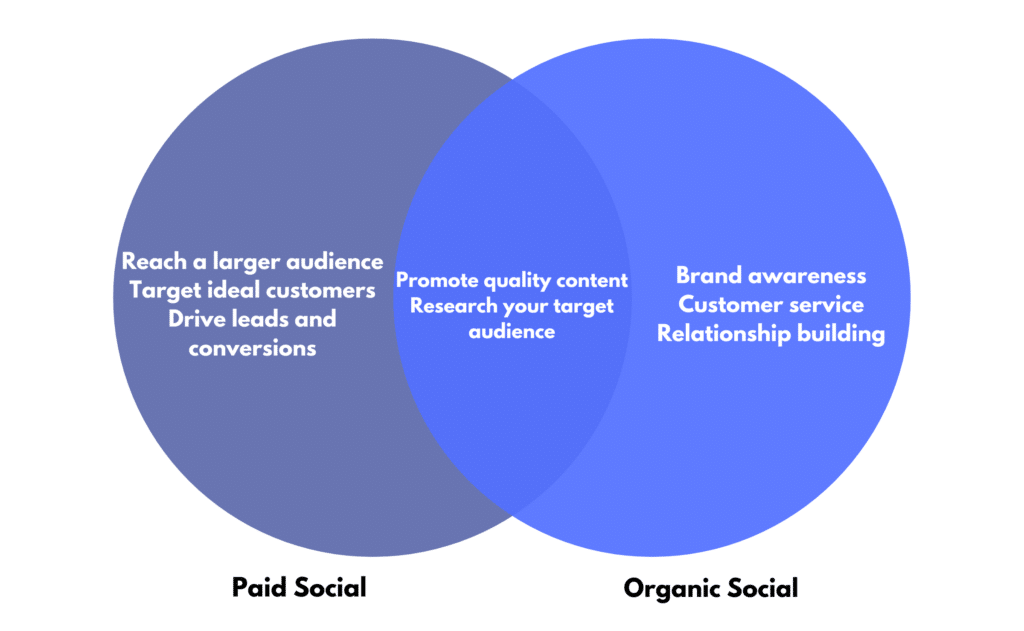
Live Chat: Real-Time Solutions
A live chat feature on your website can be the difference between a visitor and a lead. It offers instant assistance, which not only improves user experience but also increases the chances of conversion. Statistics show that customers who use live chat are 2.8 times more likely to convert.
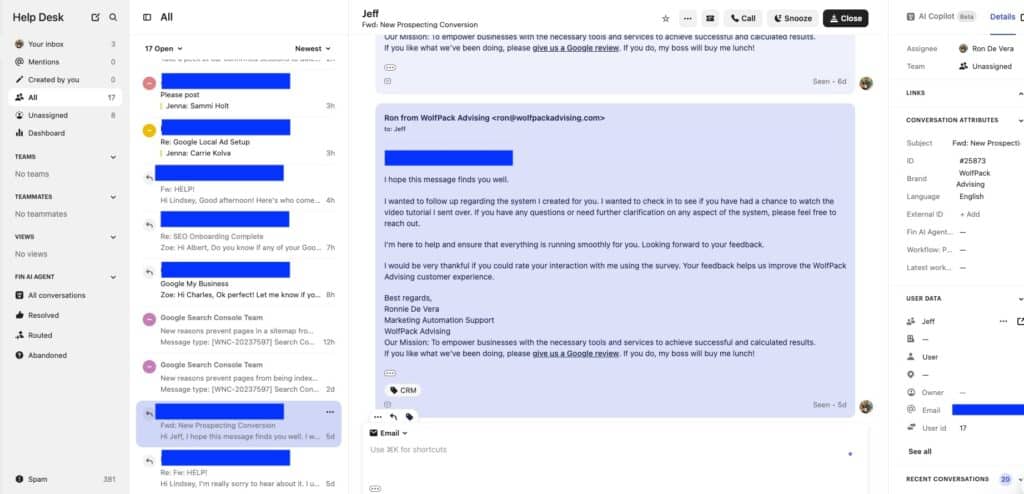
Freebies: The Art of Giving to Get
Providing free resources in exchange for contact details is a classic yet effective lead-generation strategy. Whether it’s an ebook, a webinar, or a template, make sure it adds real value. This approach not only garners leads but also begins the relationship on a positive note of generosity.
By implementing these strategies, you’re not just chasing leads—you’re building a community of interested prospects and guiding them through the journey to becoming valued customers. Remember, lead generation is both an art and a science; refine your techniques continually and watch your business thrive.
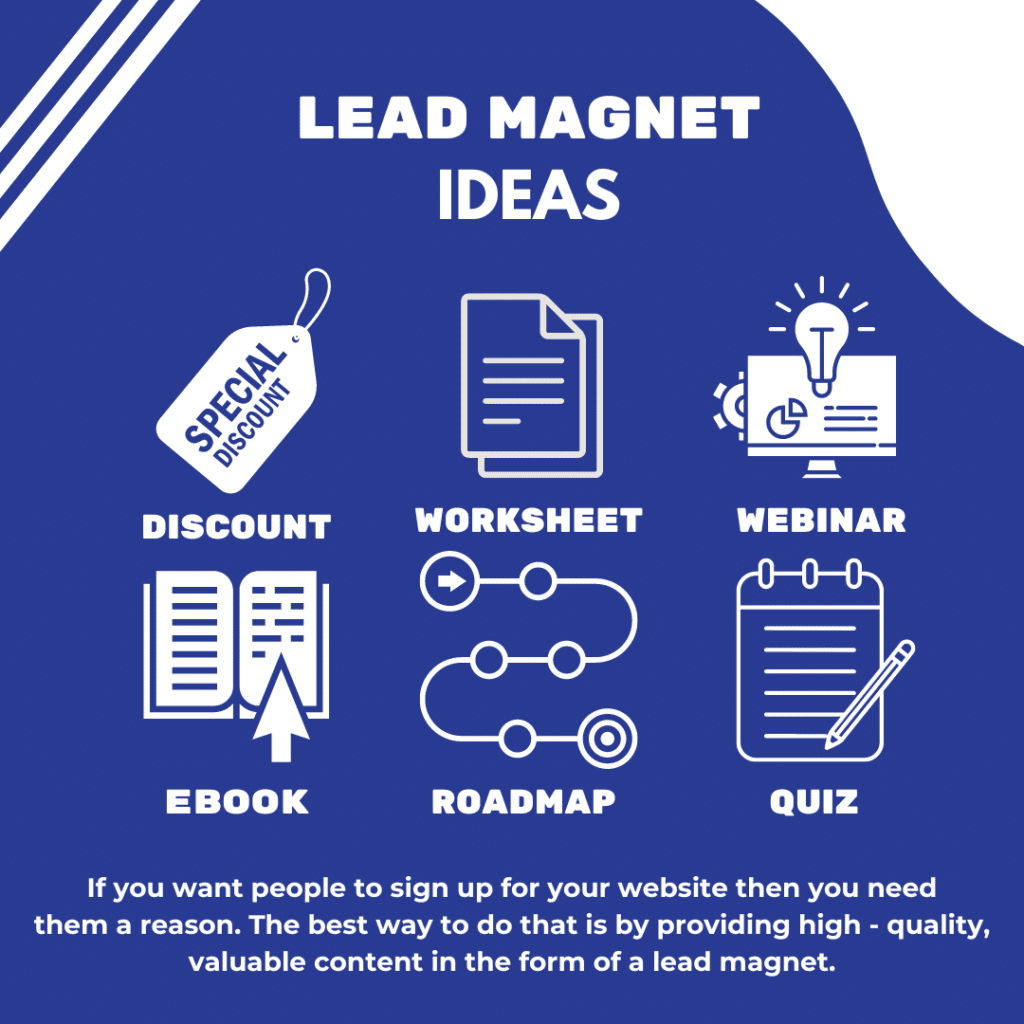
Conclusion
In conclusion, targeted lead generation is a cornerstone of any thriving business. Wolfpack Advising understands the nuances of connecting with the right audience and converting them into loyal customers. By embracing the strategies we’ve discussed, you can elevate your sales and marketing efforts to new heights.
Let Wolfpack Advising guide you through this process; together, we will unlock the full potential of your lead generation activities and set your business on a path to sustained growth and success. Ready to take your digital marketing efforts to the next level? Schedule a consultation or get a proposal from WolfPack Advising. Let’s take your digital presence to new heights!


